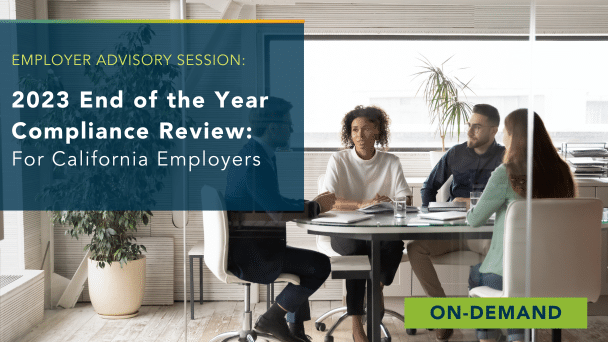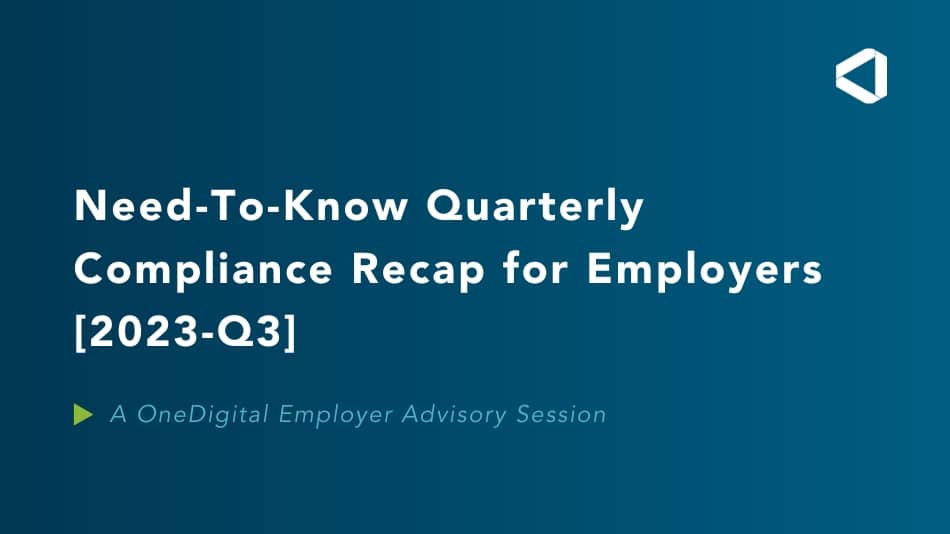No Headaches, Vibe
Wrapping Up 2020: Employer Considerations for the New Year
Wrapping Up 2020: Employer Considerations for the New Year
Who could blame anyone for wanting to fast forward as quickly as possible to 2021? This past year has been fraught with so many difficulties, new pains and old.
During all of this, I hope you have found clarity and gratefulness for what you hold most dear.
As anxious as we may be to get to January 1st, let’s take a quick inventory of what needs attention before the year ends.
Employment Law Updates
Be sure to reassess any applicable local, state and federal law updates. Aside from OneDigital’s compliance advisory sessions, one of the easiest ways to get an overview is through the free webinars that major law offices offer this time of the year. Additionally, you can get updates from your local/state chamber of commerce websites.
Watch SHRM’s on-demand webinar available through February 2021 entitled, “Posting Compliance: Are You Ready for 2021?” This webinar highlights 2020’s posting changes and preview updates to expect in the coming months. They also go through the ins and outs of posting compliance for remote workers (we have tons of them now!).
Action Items
- Once you have identified the relevant changes, make sure to update policies, processes, and/or employee handbooks. Then, communicate these changes to all applicable stakeholders.
- Ensure that your clients are replacing outdated posters with the 2021 versions.
COVID-19 Considerations
To say COVID-19 related HR matters to the workplace are “fluid” would be an understatement at best. The experience feels more like trying to nail Jell-O to the wall, yes? Keeping that in mind, I’d like to emphasize areas of importance with this newfound and unchartered responsibility.
The Federal government instituted the Family First Coronavirus Response Act (FFCRA) at the onset of the pandemic—this expires 12-31-20. Currently, an extension of the FFCRA has not been announced. Local and state versions are also about to expire before or by end of year. This “nail biter” begs the question, “Will these new leaves be extended, or do I put the employee on the former leaves in play the last 30 years?”
The “Wandering Workforce”—a term used by Littler Mendelson attorney Bruce J. Sarchet during a COVID webinar I recently attended—was so relatable. The blitz of remote workers was sudden, and many employers were not prepared for this type of work arrangement from an infrastructure standpoint, let alone the workforce impacts it would bring. Issues range from applying the correct payroll tax if your employee in New York is now working from their in-law's house in Vermont to employee relations situations like “Why can’t I work remotely…permanently?” and more—I’m sure you can think of a few that have come your way.
Reporting requirements and return to work protocols vary throughout the country as well. New laws on matters like this go into effect on 01-01-21; for example, California’s AB 685 and New Jersey’s EO 192. Other new laws have come in the form of prohibiting retaliation against employees for staying at home due to COVID-19, as seen in Michigan’s HB 6032.
Action Items
- First, deep breath in…and exhale… It’s a lot—right? You’ve got this though.
- Stay on top of what is happening with local, state, and federal leave laws pertaining to COVID-19. If there is not an extension of the FFCRA or in your local or state leaves, you can fall back to the ever reliant FMLA or for employees who are not FMLA eligible, look at ADA or FEHA for CA.
- Capture the questions you’ve been getting from your clients and collaborate on answers. Get legal advice where you’re unclear. Then, consider creating an on-going FAQ document that can be distributed to varying audiences like their HR staff, business leaders and employees. Perhaps an internal webinar with the client’s employees and/or leaders would be a helpful complement to the FAQ’s.
- Use resources like this guide from Littler that tracks state return to work protocols.
Strategic HR Planning
Don’t lose sight of the value you can bring to your clients in flexing your strategic muscles while caring for all the administrative or compliance priorities.
Action Items
- Schedule a meeting with your clients to facilitate a discussion about their business objectives for next year.
- Take a moment to reflect on the HR opportunities that came up during the year and potential solutions. Use this blended information to create an aligned HR plan to support the client’s business goals and create HR improvements. Review the plan with the client and get their input to finalize the plan. Finally, execute and measure results throughout 2021.
- Don’t forget the communication plan to ensure the client is regularly updated on positive results and when course correction is needed.
That’s a wrap (I couldn’t resist). I wish you all some much-needed rest and relaxation over the holidays and a very Happy New Year!
As you prepare your workforce strategy for 2021, examine how HR is responding to the ongoing changes in the workplace by addressing four critical workplace trends. Check out the recent podcast: Emerging Trends in HR and Workforce Management - The New Focus on Human Experience.
Share
Related News & Updates

Article
Federal & State Labor Law Posters
11.13.2023



